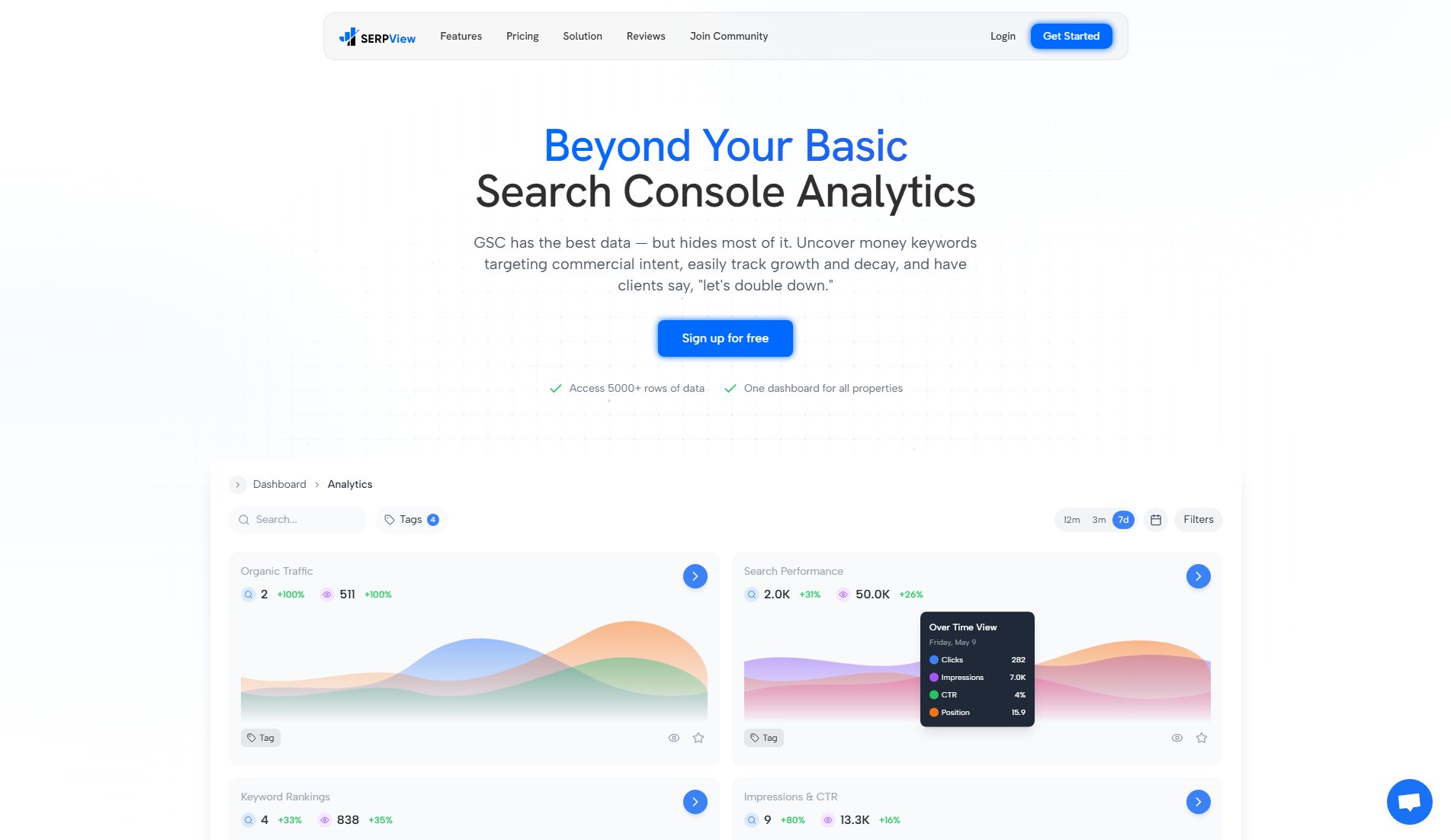SERPView
Unlock hidden Google Search Console data for advanced SEO insights
What is SERPView? Complete Overview
SERPView is a powerful analytics dashboard that enhances Google Search Console (GSC) by unlocking hidden data and providing advanced SEO insights. It solves the pain points of GSC's limitations, including the 1,000-row data restriction, lack of historical data access, and difficulty in tracking keyword performance. The tool is designed for SEO professionals, digital marketers, and webmasters who manage multiple websites or client accounts. SERPView offers 50,000+ rows of data access (compared to GSC's 1,000), comprehensive keyword and page performance metrics, and the ability to track performance across multiple properties in one dashboard. It transforms traditional search analytics into a streamlined, data-rich process with visual representations and pre-built reports.
SERPView Interface & Screenshots

SERPView Official screenshot of the tool interface
What Can SERPView Do? Key Features
Enhanced Data Access
Access up to 50,000 rows of search performance data (50x more than GSC's limit) with no restrictions on tracking clicks, impressions, CTR, and position. This comprehensive data access reveals valuable keywords that might be hidden in standard GSC data.
Keyword Analysis
Uncover money keywords targeting commercial intent and track their position changes over time. Identify new opportunities with detailed metrics showing position, clicks, and performance trends for each keyword.
Page Performance Analysis
Analyze which pages are performing best in search results with detailed metrics on clicks, CTR, and position. Identify underperforming content and optimization opportunities with historical comparison data.
Device Comparison
Compare search performance across mobile and desktop devices to identify optimization opportunities. View percentage distribution and performance trends for each device type over selected time periods.
International SEO Insights
Track performance across different countries and languages to optimize your global SEO strategy. View top countries by impressions and analyze region-specific performance metrics.
Query Counting
Analyze how many different search queries generate impressions for your site, broken down by position ranges. Track changes in query distribution across ranking positions over time.
Google Updates Tracking
Correlate ranking changes with Google algorithm updates by adding custom annotations to your performance charts. Visualize how updates impact your search performance over time.
Multi-Property Dashboard
Connect and manage multiple Google Search Console properties in a single dashboard. View all your search data in one place with unified reporting and analysis tools.
Best SERPView Use Cases & Applications
SEO Agency Managing Multiple Clients
An SEO agency uses SERPView to manage all client accounts in one dashboard, saving hours of switching between GSC accounts. They identify high-value keywords for each client, track position improvements, and create white-labeled reports to demonstrate ROI.
E-commerce Site Optimization
An e-commerce manager uses SERPView to analyze product page performance, identifying which pages rank for commercial intent keywords but have low CTR. They optimize meta titles and descriptions, resulting in a 38% increase in clicks from search.
Content Strategy Refinement
A content marketer uses the Topic Clusters feature to analyze performance across content categories. They discover underperforming topics and redistribute resources, leading to a 26% increase in organic traffic to priority content areas.
International SEO Management
A global brand uses the International Insights to compare performance across different countries. They identify regions with untapped potential and localize content accordingly, achieving 12% growth in target markets.
How to Use SERPView: Step-by-Step Guide
Sign up for a free SERPView account and connect your Google Search Console properties by granting read-only access (takes less than 2 minutes).
Configure your dashboard by selecting the properties and date ranges you want to analyze. Set up custom filters to focus on specific aspects of your search performance.
Explore the various reports including Keyword Analysis, Page Performance, Device Comparison, and International Insights to uncover valuable SEO opportunities.
Use the annotation feature to mark important events (like website changes or Google updates) and correlate them with performance changes in your data.
Share insights with your team or clients through white-labeled reports, or export data for further analysis in other tools.
Regularly monitor your dashboard to track progress, identify new opportunities, and adjust your SEO strategy based on data-driven insights.
SERPView Pros and Cons: Honest Review
Pros
Considerations
Is SERPView Worth It? FAQ & Reviews
SERPView only temporarily stores a Google key to build your dashboard. We don't store or use your GSC data. Access is revoked when you disconnect, similar to other GSC-connected apps.
It upgrades GSC's analytics but doesn't replace tools like sitemap submissions. SERPView becomes your primary analytics tool while you still use GSC for certain functions.
Only read-only access to your Google Search Console data. No access to other Google services or products is required or granted.
No, it uses exact data from GSC without estimations. The interface enhances how you view and interact with your actual GSC data.
SERPView provides access to 50,000+ rows compared to GSC's 1,000-row limit, giving you a more complete picture of your search performance.
You can access up to 16 months of historical data from Google Search Console through SERPView.
Data syncs multiple times daily with GSC, and you can manually refresh anytime for the latest information.
Yes, SERPView allows you to connect and manage multiple GSC properties in one dashboard, making it ideal for agencies and professionals managing multiple clients.